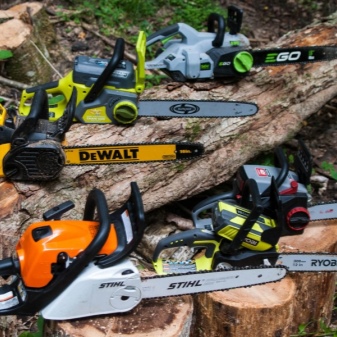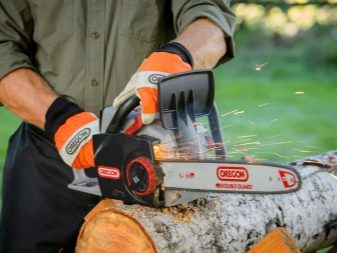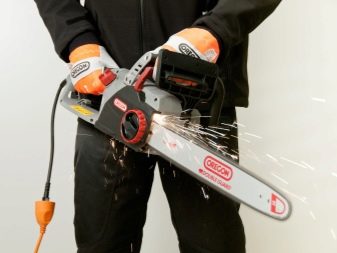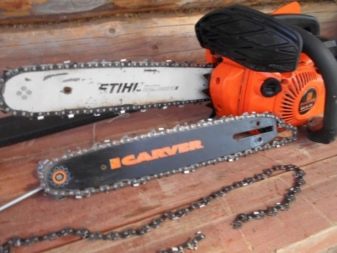Which saw is better: electric or gasoline?

Recently, electric chain saws are becoming more common. They are compact and low in price - an electric saw can cost ten times cheaper than a gasoline saw. However, in specific conditions, both the one tool and the other have an advantage.


Design features
Chainsaw construction is not very different in general terms. In any case, the saw chain is the working element of the chain saw. It consists of small segments with a sharp tooth, which are pivotally connected to each other in a closed ring.
The movement of the chain is guided by an elongated groove bar along the end of the entire perimeter. At the ends of the bar there are sprockets, between which the saw chain ring is stretched. The groove of the bar, along which the tensioned chain slides, guides its movement and provides pressure on the chain when cutting.
The assembled set of bar, sprockets and an installed saw chain is called a "saw headset".

On one side, the headset is attached to the frame and the chain saw motor. In the tire attachment point, one of the sprockets is connected to the main gearbox of the unit and provides the chain drive with the energy of the unit's engine. The mount allows you to rotate the headset and change the angle of its inclination relative to the motor unit.
The difference between the two types of saws lies in the design of the motor. An electric chain saw uses an electric motor as a motor. The gasoline saw for driving the chain contains an internal combustion engine in the structure.
Most of these units use two-stroke engines. They require gasoline with a small amount of engine oil to operate. The exact brands of gasoline and oil, as well as their proportions, are indicated in the instrument's passport.


Compare chainsaws and electric saws
There are many factors to consider when choosing a tool. This includes the required amount of work, and the conditions at the workplace, and possible restrictions on noise and environmental pollution.
Scope of application
Differences in the design of the units lead to the peculiarities of using chain saws of different designs. When working at home, the master is not limited to connecting to electricity. The cable length of any electric saw is usually enough to reach the nearest outlet. At the same time, homework for the most part does not require high power or tool performance.
Logging and construction work involves a powerful and productive tool. Not all household power saws can handle thicker logs or sturdy planks. Gasoline units are much more convenient in these conditions.
Electric chain saws have no poisonous exhaust and are almost silent. The saw is lightweight and easy to operate. However, when working with an electric tool, keep in mind that high humidity (for example, morning dew in the garden) can lead to an electric shock to the operator.


Gasoline units are easier to carry from place to place. They are convenient when working in large rooms and in open areas. But chainsaws make a lot of noise and exhaust fumes require good ventilation in the workplace. The use of gasoline units in confined spaces is not always possible.
A comparison of the features of gasoline and electric chain saws shows that the electric chain saw is out of competition for small household jobs. Working in the forest, on a construction site, makes you give preference to chainsaws. But for summer cottages and gardening, both types of units are equally suitable.
It should only be borne in mind that working with an electric saw in high humidity conditions can be dangerous.


Mobility
Using an electric saw, the craftsman is "tied" with a wire to an electrical outlet. When working indoors, this is not burdensome at all.
Another extreme situation is a forest, for example. To start the electric saw, you need a stand-alone generator. This is often quite convenient, but a gas saw will still provide the advantage of moving.
Even in a garden area, a long electric cable will create significant inconvenience. The wire must be moved from place to place, make sure that it does not damage the garden plantings and does not fall into the reservoir.
The light weight and compactness of a power saw can outweigh the disadvantages of a power cord. Still, it is much easier for women to wield an electric saw. A man is more likely to give preference to a chainsaw - albeit heavy, but providing greater freedom of movement.


Reliability
Due to the simplicity of the design, an electric chain saw may, other things being equal, be more reliable than a chainsaw. It does not have a complex internal combustion engine. The electric motor starts instantly and can be turned off at any second. It does not depend on the quality of the fuel and the availability of engine oil.
Modern chainsaws are also quite reliable. Long gone are the days when a lumberjack had to suffer for half an hour trying to launch the old "Friendship". And now there is no need to carry a box of spare parts. The new chainsaw starts with literally one pull of the cord and serves faithfully for at least two to three years.


In addition, gasoline saws have historically been a tool for professionals. There are almost no cheap chainsaws, and the available ones are designed for difficult working conditions and heavy loads. Unfortunately, most electric saws are designed for infrequent use in "greenhouse" conditions and cannot boast of workmanship.
In any case, when buying a tool, you should not save. Whether a saw, even an electric one, even a gasoline one - this is a complex technical device. The cheapest devices are unlikely to last long. And given that the saw is already a source of increased risk, it is quite possible to get injured by saving money when buying.

Performance
Most electric chain saws are designed for “home” use. They are compact, lightweight, but less powerful than chainsaws. If you need to cut several boards, trim openings in a wooden wall or cut some firewood, the performance of the electric saw is sufficient.
Gasoline saws were originally designed for bulky workpieces and have more power than electric ones.
If you need to cut thick logs, harvest a lot of firewood, cut strong beams during the construction of a house - a chainsaw will allow you to do this work much faster.



The unit is easy to carry from place to place, changing the area of work. In order to start working in a new place, for an electric saw, you will need to install an outlet nearby and spend time re-arranging the electrical cable. In addition, when working, you have to make sure that the wire itself does not accidentally fall under the saw teeth.
Any engine heats up during operation. When working with an electric saw, you have to take breaks for ten to fifteen minutes every half hour to cool the motor. But chainsaws are able to work for hours without interruption. This also leads to the fact that the chainsaw is a more productive tool.


Economy
An electric chain saw is generally much cheaper. The simplicity of the design allows selling electric saws for a lower price, comparable in power and performance with more expensive gasoline "brothers".
Plus, electricity is relatively cheap. Using an electric saw, you can practically not worry about the price of its "fuel".
A chainsaw is considerably more onerous in terms of operating costs. For starters, the petrol chain saws themselves are significantly more expensive than electric trains. They are more complex. In addition, chainsaws are traditionally designed to be known to be reliable - and therefore expensive.



The cost of chainsaw consumables (gasoline and engine oil) is also thought provoking. Fuel is constantly becoming more expensive, and the chainsaw is a very "gluttonous" consumer of fuel.
However, sometimes the need to work "in the field" allows you to put up with the high cost of using gasoline saws. In addition, the inherently longer service life of the chainsaw makes the investment in a tool more rational than buying a “disposable” electric chain saw.

Ease of service
The electric saw is very simple and therefore easier to maintain. The electric motor is practically maintenance-free. To move the bar or change the saw chain, on most electric saws, simply unscrew the large handy nut with a handle by hand. Almost all maintenance comes down to timely lubrication of the tire and the main gearbox.
It is very easy to start using your electric saw: just plug it into a power outlet. In the case of a chainsaw, you will need to prepare a fuel mixture, pour it into the gas tank, check for lubrication in the engine and gearbox. The petrol engine is started manually by pulling the starter cord firmly on the handle. It is not always possible to start the engine the first time. Sometimes it is necessary to conjure up with the additional fuel supply valve and the position of the "gas" button at the moment of starting.
Gasoline chain saws require much more care and attention. In addition to lubricating the tire and gearbox, you have to carefully monitor the level of engine lubrication and the quality of the fuel mixture.


The mixture of gasoline and engine oil itself also needs to be prepared and the saw's fuel tank refilled in time. After mixing, the fuel mixture is poorly stored, so it has to be prepared every time just before work.
Even changing the tire on a chainsaw is more difficult than on an electric one, since it requires a special tool.
But an experienced user can repair a chainsaw in his workshop, and even in the forest. Electric saws - if they break down - have to be taken to a specialized service center.


Which saw is best for giving?
When working at home or in the country, people are usually close to an electrical outlet. And the volume of work on the site is not as great as on logging. Typically, for home use, the capabilities of electric chain saws are sufficient.
It is important that storage of an electric saw does not require a lot of space; it can be kept in a workshop or even in a residential building. A gasoline saw smells like gasoline and is always covered in oil and soot from the exhaust. The chainsaw has to be stored in a special place - usually in a barn.
The chainsaw is more convenient if you have to file through the intricate weaving of the garden. Even to the far edge of the site, it is not always convenient to stretch the electrical wire necessary for working with an electric saw. And it is not safe to use an electric tool in wet weather.



For the home, it is better to choose an electric saw. In the country, a chainsaw is more appropriate. But if money and conditions permit, it is useful to have both. The compact, lightweight and non-polluting electric saw proves to be indispensable for work in the home and workshop. Powerful and autonomous, the chainsaw helps you harvest firewood, build buildings and cultivate your garden.
Any tool has a worthy application. The main thing is to take into account its features, advantages and disadvantages. That said, it's helpful to take into account the feedback from people who have worked with both types of tools.
For information on which saw to choose, gasoline or electric, see below.













The comment was sent successfully.